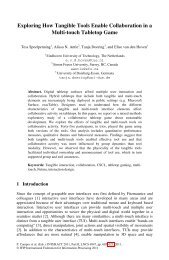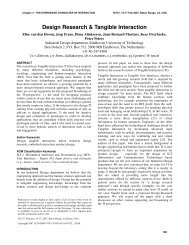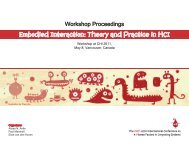Sissy - Elise van den Hoven
Sissy - Elise van den Hoven
Sissy - Elise van den Hoven
You also want an ePaper? Increase the reach of your titles
YUMPU automatically turns print PDFs into web optimized ePapers that Google loves.
“Now come back to the scale of the human heart and<br />
remember the feeling and the sound of your pulse.”<br />
AUDIENCE TESTING<br />
We invited six people to participate in our audience<br />
testing. We wanted a range of body types and people with<br />
an interest in the kind of work we were doing. The<br />
participants had backgrounds in architecture, dance, film,<br />
new media, production and performance. There were four<br />
women and two men. Each participant was scheduled to<br />
arrive at a set time to ensure an even flow of people<br />
throughout the installation. Information sheets and ethics<br />
consent forms were available in the waiting area, prior to<br />
entering the installation space. Each participant was met<br />
by one of the artists and guided through the installation.<br />
Video documentation of the artwork is at<br />
http://vimeo.com/25535870.<br />
We recorded participants verbally recounting their<br />
experience of the installation at the Recall Station and<br />
invited them to provide written feedback in response to a<br />
set of questions (see Table 1).<br />
Table 1. Feedback Form questions<br />
Q1 What were the pivotal moments in your experience of each work<br />
(Lung Station – standing and being bound, Heart Station – lying on<br />
bed with objects, Spine Station – lying down back to back)?<br />
Q2 What factors contributed to, or detracted from, the experiential<br />
flow in each work?<br />
Q3 Were there specific stations that could be shorter or longer in<br />
duration? If you could change some of the timings or transitions,<br />
what would you make longer or shorter?<br />
Q4 Did any of these stations give you a different experience of your<br />
body? If so, what influenced that experience?<br />
Q5 Choose 3 words that vividly describe your experience.<br />
DATA ANALYSIS<br />
For this paper the focus is on audience bodily experience:<br />
how people experienced their body during the encounter<br />
and what factors played a role in influencing that<br />
experience. The data is analysed from a number of<br />
analytic lenses: the relationship between the embodied<br />
imagination and felt sensation; the influence of objects<br />
and costume; and the sonically mediated experience of<br />
physiological processes of breathing and heartbeat. We<br />
will limit our discussion here to the reports from the two<br />
stations incorporating explicit use of the Whale Body<br />
metaphor and digital technologies – the Lung Station and<br />
the Heart Station. The results of the analysis are discussed<br />
in the following sections.<br />
Lens 1: The relationship between the embodied<br />
imagination and felt sensation<br />
The interest here is on the relationship between<br />
imagination and its experiential effect on the body. The<br />
term ‘embodied imagination’ refers to the intertwining of<br />
our imaginative capacities and the felt experience of the<br />
body. It brings to the foreground the understanding that<br />
our mind and body are fundamentally connected in<br />
creative and transformative ways. In this project, we were<br />
specifically looking at the use of imagery to transform<br />
one’s perception and experience of self and the world.<br />
28<br />
This lens includes the use and influence of language on<br />
how people experience and imagine their bodies.<br />
A distinction is made between associative images that are<br />
understood mentally and transformative images that are<br />
deeply felt in the body. In the audience recounts, we<br />
i<strong>den</strong>tified associative images whenever a person used<br />
language such as “it reminded me of …” or “it brought up<br />
memories”. For example, P4 describes how her<br />
experience of the Lung Station (the constriction of the<br />
straps and the attention to breath) reminded her of a<br />
conversation with a pregnant friend and the friend’s<br />
description of carrying the child inside being like “her<br />
body the membrane between universes”. Here the image<br />
is a reference, an association. The image itself is not<br />
necessarily felt in the body in a transformative sense. An<br />
example of a transformative image is given by P1 where<br />
he describes his feeling state at the Recall Station, “It<br />
feels like a whole body space. I’m inside someone’s<br />
body, I’m having that … sensation now, we’re just …<br />
inside the whole body.” And, “The whale imagery sent<br />
me the feeling like I’m inside a whale.”<br />
P3 provides an interesting example of the transition from<br />
thinking mentally about an image to actually feeling the<br />
image in the body. She comments that the straps fastened<br />
along the length of her body “assisted with actually being<br />
able to imagine myself as a whole body […] It made me<br />
feel like I was one piece” (our emphasis).<br />
Observations made by participants pointed to the paradox<br />
of being physically restricted in some way yet invited to<br />
expand their bodily sense through their imagination,<br />
particularly with the Whale Body metaphor. The<br />
following quotes from participants are testament to this.<br />
“Oppositions. Bound physically. Lying with stones or<br />
another body but focusing on vastness like Whale Lung.”<br />
“To think of the body as a whale was interesting as the<br />
size of the creature opened up my body and mind to think<br />
of a new scale.”<br />
The Whale Body metaphor operated for some participants<br />
as a meta-image for the entire experience in the space.<br />
Lens 2: The influence of objects and costume<br />
In the Lung Station, the constrictive straps played a major<br />
role in how people perceived their bodies and the process<br />
of breathing.<br />
“The binding, however, shifted my focus to the operation<br />
of breathing; the shifting volumes of oxygen; taking my<br />
sensibility, paradoxically, deeper within and expansively<br />
outward.” This example illustrates P5’s experience of the<br />
act of breathing shifting from a sense of the breath<br />
flowing in and out to a spatial sense of breathing and the<br />
expansion and contraction of the lungs and body. P3<br />
describes the effect of the binding as conveying the<br />
essence of a single lung.<br />
In the Heart Station, the experience of the stones on the<br />
body yielded some interesting insights. “Rocks<br />
replaced/became body parts. Imagined/experience of<br />
womb, weight of baby.” The weight and pressure of the<br />
variously sized stones on the torso, belly, neck or face of



![Download 1.8 MB [pdf] - Elise van den Hoven](https://img.yumpu.com/18078175/1/190x245/download-18-mb-pdf-elise-van-den-hoven.jpg?quality=85)

![Download 0.2 MB [pdf] - Elise van den Hoven](https://img.yumpu.com/18078145/1/182x260/download-02-mb-pdf-elise-van-den-hoven.jpg?quality=85)
![Download 0.1 MB [pdf] - Elise van den Hoven](https://img.yumpu.com/18078125/1/190x146/download-01-mb-pdf-elise-van-den-hoven.jpg?quality=85)
![Download 1.9 MB [pdf] - Elise van den Hoven](https://img.yumpu.com/18078041/1/182x260/download-19-mb-pdf-elise-van-den-hoven.jpg?quality=85)

